
A firearm is any type of gun that uses an explosive charge and is designed to be readily carried and used by an individual. The term is legally defined further in different countries.

A rifle is a long-barreled firearm designed for accurate shooting and higher stopping power, with a barrel that has a helical pattern of grooves (rifling) cut into the bore wall. In keeping with their focus on accuracy, rifles are typically designed to be held with both hands and braced firmly against the shooter's shoulder via a buttstock for stability during shooting. Rifles are used extensively in warfare, law enforcement, hunting and target shooting sports.

In firearm designs, the term single-shot refers to guns that can hold only a single round of ammunition inside and thus must be reloaded manually after every shot. Compared to multi-shot repeating firearms ("repeaters"), single-shot designs have no moving parts other than the trigger, hammer/firing pin or frizzen, and therefore do not need a sizable receiver behind the barrel to accommodate a moving action, making them far less complex and more robust than revolvers or magazine/belt-fed firearms, but also with much slower rates of fire.

The 5.56×45mm NATO is a rimless bottlenecked intermediate cartridge family developed in the late 1970s in Belgium by FN Herstal. It consists of the SS109, L110, and SS111 cartridges. On 28 October 1980, under STANAG 4172, it was standardized as the second standard service rifle cartridge for NATO forces as well as many non-NATO countries. Though they are not entirely identical, the 5.56×45mm NATO cartridge family was derived from and is dimensionally similar to the .223 Remington cartridge designed by Remington Arms in the early 1960s.

A bullet is a kinetic projectile, a component of firearm ammunition that is shot from a gun barrel. They are made of a variety of materials, such as copper, lead, steel, polymer, rubber and even wax; and are made in various shapes and constructions, including specialized functions such as hunting, target shooting, training, and combat. Bullets are often tapered, making them more aerodynamic. Bullet size is expressed by weight and diameter in both imperial and metric measurement systems. Bullets do not normally contain explosives but strike or damage the intended target by transferring kinetic energy upon impact and penetration.

A cartridge, also known as a round, is a type of pre-assembled firearm ammunition packaging a projectile, a propellant substance and an ignition device (primer) within a metallic, paper, or plastic case that is precisely made to fit within the barrel chamber of a breechloading gun, for convenient transportation and handling during shooting. Although in popular usage the term "bullet" is often used to refer to a complete cartridge, the correct usage only refers to the projectile.

Flintlock is a general term for any firearm that uses a flint-striking ignition mechanism, the first of which appeared in Western Europe in the early 16th century. The term may also apply to a particular form of the mechanism itself, also known as the true flintlock, that was introduced in the early 17th century, and gradually replaced earlier firearm-ignition technologies, such as the matchlock, the wheellock, and the earlier flintlock mechanisms such as the snaplock and snaphaunce.

A musket is a muzzle-loaded long gun that appeared as a smoothbore weapon in the early 16th century, at first as a heavier variant of the arquebus, capable of penetrating plate armour. By the mid-16th century, this type of musket gradually disappeared as the use of heavy armour declined, but musket continued as the generic term for smoothbore long guns until the mid-19th century. In turn, this style of musket was retired in the 19th century when rifled muskets using the Minié ball became common. The development of breech-loading firearms using self-contained cartridges and the first reliable repeating rifles produced by Winchester Repeating Arms Company in 1860 also led to their demise. By the time that repeating rifles became common, they were known as simply "rifles", ending the era of the musket.

The Minié ball or Minie ball, is a type of hollow-based bullet designed by Claude-Étienne Minié, inventor of the French Minié rifle, for muzzle-loading rifled muskets. It was invented in 1846 and came to prominence during the Crimean War and the American Civil War, where it was found to inflict significantly more serious wounds than earlier round musket balls. Both the American Springfield Model 1861 and the British Pattern 1853 Enfield rifled muskets, the most common weapons used during the American Civil War, used the Minié ball.

The .303 British or 7.7×56mmR, is a .303-inch (7.7 mm) calibre rimmed rifle cartridge. The .303 inch bore diameter is measured between rifling lands as is the common practice in Europe which follows the traditional black powder convention.
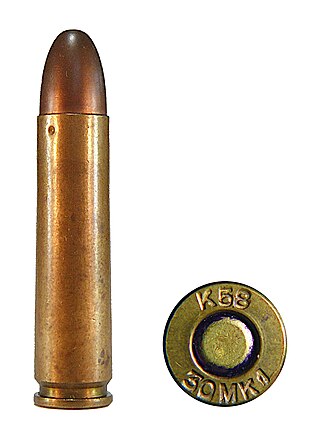
The .30 Carbine (7.62×33mm) is a rimless carbine/rifle cartridge used in the M1 carbine introduced in the 1940s. It is a light rifle round designed to be fired from the M1 carbine's 18-inch (458 mm) barrel.
A rifled musket, rifle musket, or rifle-musket is a type of firearm made in the mid-19th century. Originally the term referred only to muskets that had been produced as a smoothbore weapon and later had their barrels replaced with rifled barrels. The term later included rifles that directly replaced, and were of the same design overall as, a particular model of smoothbore musket.
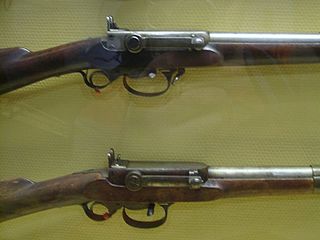
The Kammerlader, or "chamber loader", was the first Norwegian breech-loading rifle, and among the first breech loaders adopted for use by an armed force anywhere in the world. A single-shot black-powder rifle, the kammerlader was operated with a crank mounted on the side of the receiver. This made it much quicker and easier to load than the weapons previously used. Kammerladers quickly gained a reputation for being fast and accurate rifles, and would have been a deadly weapon against massed ranks of infantry.
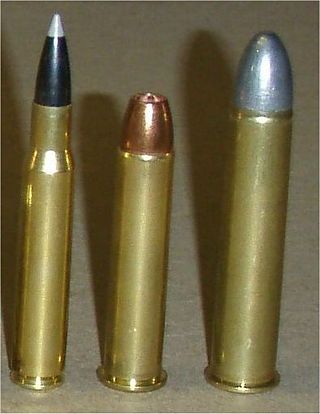
The .45-70, also known as the .45-70 Government, .45-70 Springfield, and .45-21⁄10" Sharps, is a .45 caliber rifle cartridge originally holding 70 grains of black powder that was developed at the U.S. Army's Springfield Armory for use in the Springfield Model 1873. It was a replacement for the stop-gap .50-70 Government cartridge, which had been adopted in 1866, one year after the end of the American Civil War, and is known by collectors as the "Trapdoor Springfield".
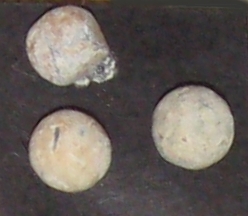
Buck and ball was a common load for muzzle-loading muskets, and was frequently used in the American Revolutionary War and into the early days of the American Civil War. The load usually consisted of a .50 to .75 caliber round lead musket ball that was combined with three to six buckshot pellets.
The 5.8×42mm / DBP87 is a military bottlenecked intermediate cartridge developed in the People's Republic of China. There is limited information on this cartridge, although the People's Liberation Army claims that it is superior to the 5.56×45mm NATO and Soviet 5.45×39mm cartridges.

The 6.5x50mmSR Arisaka is a semi-rimmed rifle cartridge with a 6.5 mm diameter bullet. It was the standard Japanese military cartridge from 1897 until the late 1930s for service rifles and machine guns when it was gradually replaced by the 7.7×58mm Arisaka.
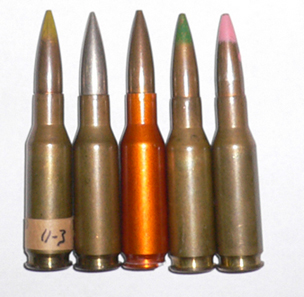
The .280 British was an experimental rimless bottlenecked intermediate rifle cartridge. It was later designated 7 mm MK1Z, and has also been known as .280/30, .280 Enfield, 7 mm FN Short and 7×43mm.
A paper cartridge is one of various types of small arms ammunition used before the advent of the metallic cartridge. These cartridges consisted of a paper cylinder or cone containing the bullet, gunpowder, and in some cases, a primer or a lubricating and anti-fouling agent. Combustible cartridges are paper cartridges that use paper treated with oxidizers to allow them to burn completely upon ignition.
During the American Civil War, an assortment of small arms found their way onto the battlefield. Though the muzzleloader percussion cap rifled musket was the most numerous weapon, being standard issue for the Union and Confederate armies, many other firearms, ranging from the single-shot breech-loading Sharps and Burnside rifles to the Spencer and the Henry rifles - two of the world's first repeating rifles - were issued by the hundreds of thousands, mostly by the Union. The Civil War brought many advances in firearms technology, most notably the widespread use of rifled barrels.















